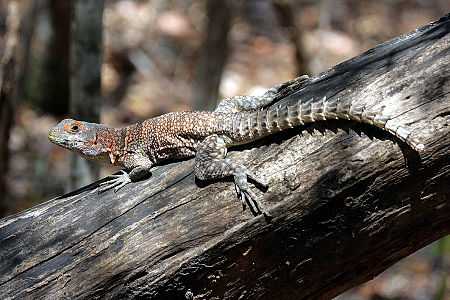Opluridae
| Opluridae | |
|---|---|
 | |
| Oplurus cuvieri | |
| Scientific classification | |
| Kingdom: | Animalia |
| Phylum: | Chordata |
| Class: | Sauropsida |
| Order: | Squamata |
| Suborder: | Lacertilia |
| Infraorder: | Iguania |
| Family: | Opluridae |
| Genera | |
|
2 genera (7 recognized species), see article. | |
The Opluridae, or Madagascan iguanas, are a family of moderately sized lizards native to Madagascar. There are seven species in two genera, with most of the species being in Oplurus. The family includes species that live amongst rocks, some that live in trees, and one that inhabits sand dunes. All of the species lay eggs, and have teeth that resemble those of the true iguanas.[1]
The two genera are easily distinguished. The smaller monotypic Chalarodon madagascariensis has a dorsal crest, particularly distinct in males, and has a smoother tail covered in similarly sized scales. Genus Oplurus has large segmented spiny scales, and no dorsal crest along the spine.[2]
A study of mitochondrial DNA sequences has dated the split between Opluridae and Iguanidae (within which Opluridae are sometimes classified as the subfamily Oplurinae) at about 165 million years ago, during the Middle Jurassic.[3] The study supported the monophyly of the expanded Iguanidae, and put Oplurinae in the basal position. This dating is consistent with a vicariant origin of the Madagascan iguanians, since Madagascar is believed to have separated from Africa (during the breakup of Gondwana) around 140 million years ago.[3]
Species
Family Opluridae
- Genus Chalarodon
- Genus Oplurus
References
- ↑ Bauer, Aaron M. (1998). Cogger, H.G. & Zweifel, R.G., ed. Encyclopedia of Reptiles and Amphibians. San Diego: Academic Press. p. 145. ISBN 0-12-178560-2.
- ↑ "Genus Chalarodon – Dwarf Malagasy Iguana". Cyberlizard (UK) Website. 28 July 2014. Retrieved 12 Aug 2014.
- ↑ 3.0 3.1 Okajima, Y.; Kumazawa, Y. (2009-07-15). "Mitogenomic perspectives into iguanid phylogeny and biogeography: Gondwanan vicariance for the origin of Madagascan oplurines". Gene (Elsevier) 441 (1–2): 28–35. doi:10.1016/j.gene.2008.06.011. PMID 18598742.